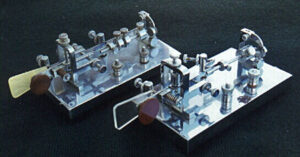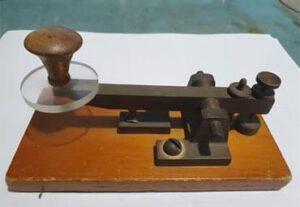By Herman Willemsen VK2IXV
Supreme Morse ‘bug’ keys and Supreme Morse straight keys (Version 1) were made by Eric Andrew Sorensen from 1953 until 1989 and sold through Tricity House Ltd, a radio store located at 209 Manchester Street, Christchurch, New Zealand.
Eric Sorensen was a retired Chief Petty Officer radio operator, who had served with the Royal New Zealand Navy, Canterbury Division, in Christchurch and was awarded the British Empire Medal (BEM) during the Queen’s visit to New Zealand in 1953/54.
Eric was born on 22 May 1909 in Orepuki, Southland and was educated at Orepuki and Riverton schools. He became a very skilled fitter and turner, and was employed as a Quality Control Inspector by Andersons Engineering Ltd, a large Christchurch company. He worked for Andersons continuously over many years, the only exception being the five-year break for his wartime service.
Eric was a member of the first Naval Echelon that was posted to war service during WW2. From 1939 to 1943 he served as a ship’s telegraphist and was then deployed to the Western Approaches Operations Centre in Liverpool, England, which he helped commission and operate.
Upon returning to New Zealand, Eric was drafted to the Navy Office in Wellington to handle codes and ciphers. Demobilised in 1945, he returned to Christchurch, to Andersons, and to the Canterbury Division of the Naval Reserve from which he retired in 1963 after 30 years of service.
In 1965 both Eric and his son Alan became licensed radio amateurs, ZL3OQ and ZL3JU respectively. It was logical that after many years of CW operation in the navy, Eric’s favourite mode of operation would be carried over into his ham radio life as well.
As a very young lad, Alan remembered his father spending many hours at work in his garage making the components for Morse keys. Alan said that “the machinery used in the manufacture of the components was totally home designed and homemade and it always worked wonderfully well.”
 Using his hand-built machines from about 1953 to 1989, Eric made many Morse straight keys and bugs, which were marketed by Tricity House.
Using his hand-built machines from about 1953 to 1989, Eric made many Morse straight keys and bugs, which were marketed by Tricity House.
Tricity House, mainly staffed by radio amateurs, was situated in central Christchurch City, where they sold and repaired small domestic appliances and wireless sets, and for many years it was the only outlet in Christchurch for amateur radio equipment and electronic components. ‘Supreme’ was a name that Tricity House used for the Morse keys made by Eric, and for various antennas made by Ron Parry ZL3VX. Tricity House closed in the 1990s.
Hundreds of Supreme keys were sold to ZL and VK amateurs. A great number were also sold to visiting ships’ radio officers, who took with them Tricity House catalogues. Many keys were sold and sent around the world by mail order.
Supreme bugs and straight keys have an excellent reputation, and were a tribute to Eric Sorensen, a fine man who became a Silent Key on 8 October 1990.
The Supreme bugs:
 These semi-automatics are well-made and robust keys with no maker’s markings. They are very easy to recognize as they look a bit like an American Vibroplex Original without a circuit closer. They always have a Perspex dot paddle and diamond-pattern knurling on their nuts. Their hardware is chrome-plated brass, except for the 16cm x 8.5cm base, which is chrome-plated steel. The bug weighs a massive 2.2 kg. The number of pendulum weights of the Supreme bug key seems to vary and can be either two or three. Other slight variations are in the design of the bug’s mainframe. The Supreme bug with the heavier mainframe has a sleeve over the pivot shaft, while the other one has not. Also, the thickness of the pendulum shaft differs slightly.
These semi-automatics are well-made and robust keys with no maker’s markings. They are very easy to recognize as they look a bit like an American Vibroplex Original without a circuit closer. They always have a Perspex dot paddle and diamond-pattern knurling on their nuts. Their hardware is chrome-plated brass, except for the 16cm x 8.5cm base, which is chrome-plated steel. The bug weighs a massive 2.2 kg. The number of pendulum weights of the Supreme bug key seems to vary and can be either two or three. Other slight variations are in the design of the bug’s mainframe. The Supreme bug with the heavier mainframe has a sleeve over the pivot shaft, while the other one has not. Also, the thickness of the pendulum shaft differs slightly.
The Supreme straight keys (first version):
 Their hardware was either plain brass or chrome-plated brass, except for the tension spring which is made of stainless steel. The base is made from rimu wood and the knob from teak. Both were lacquered. At first the base was also made from teak, but it became too hard to get and too expensive. The base measures 15 cm x 7.5 cm and the key weighs 0.4 kg. Trademarks of a Supreme straight keys are the diamond knurled nuts, a circular coloured Perspex disc under the knob and a layer of green baize (billiard cloth) under the base, to protect the screws underneath and to form an anti-slip layer.
Their hardware was either plain brass or chrome-plated brass, except for the tension spring which is made of stainless steel. The base is made from rimu wood and the knob from teak. Both were lacquered. At first the base was also made from teak, but it became too hard to get and too expensive. The base measures 15 cm x 7.5 cm and the key weighs 0.4 kg. Trademarks of a Supreme straight keys are the diamond knurled nuts, a circular coloured Perspex disc under the knob and a layer of green baize (billiard cloth) under the base, to protect the screws underneath and to form an anti-slip layer.



